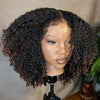Human Hair VS Virgin Hair VS Remy Hair: What Are The Differences Among Them?
Human hair, virgin hair, and remy hair are terms that are used to describe the materials of human hair wigs, which are frequently mentioned in the wig industry.
If you are on the fence about choosing a human hair wig, it is very important and necessary for you to figure out the exact meaning of these terms.
The following blog will explain the definitions of human hair, virgin hair, and remy hair to you in detail, which can help you better distinguish the differences among them.
What’s more, you will also learn how to choose among them, and save money.
1. What is Human Hair?
Human hair refers to the hair that comes from a human scalp, which can be directly cut from a person’s head, or sometimes may be collected from hairbrushes, floor scraps, and so on.
Generally speaking, human hair can be divided into three categories according to different standards and principles.
(1)In terms of sources:
According to different sources from different countries, human hair can be classified as Chinese hair, Indian hair, European hair, Brazilian hair, Malaysian hair, Cambodian hair, Mongolian hair, Peruvian hair, and so on.
(2)In terms of collection:
According to different ways of collection, human hair mainly comes from two sources.
On the one hand, the hair can be collected from people willing to donate it.
On the other hand, the hair can be collected from hairbrushes, floor scraps, and so on.
(3)In terms of process:
According to different manufacturing processes, human hair can be classified as virgin hair, remy hair, and non-remy hair.

2. What is Virgin Hair?
Virgin hair is 100% human hair, mostly with intact cuticles.
Virgin hair refers to hair that has not undergone any chemical treatment, including dyeing, perming, or bleaching, which is generally considered to be a high-quality wig raw material.
Virgin hair is hair in its natural state, exactly as originally grown from the scalp. This purity makes virgin hair highly desirable for its healthy look and feel.
It should be noted that certain types of “virgin” strands may have undergone physical processes, such as steaming to achieve desired textures and colors, and they are usually sourced from a single donor.
Different companies have different standards, so the quantities of virgin hair vary from company to company.
Occasionally, what is defined as “virgin hair” may have in fact been lightly processed and mixed with synthetic, because some companies want to save money.
The quality of virgin hair depends on the supplier, details of what treatments have been used, and what type of quality control systems they have in place.

3. What is Remy Hair?
Remy hair is 100% human hair that has all strands of hair running in the same direction, and it is collected from one or more donors, which provides a natural look and feel.
The hair cuticles making up the top layer of the hair are intact and undamaged.
What’s more, Remy hair may have undergone a slight chemical process, such as dying or perming.

4. What is Non-remy Hair?
Non-Remy hair is hair that doesn’t have all the strands running in the same direction, and it is collected from different donors, but it is still real human hair.
Non-Remy hair is human hair that has had the cuticles removed by using chemicals or has cuticles that are intact but are not aligned in the same direction, which makes the hair easy to tangle and gives it a less natural appearance.
The cost of non-remy hair is lower than that of remy hair. Non-remy hair is a suitable choice for customers with a tight and limited budget.
However, non-remy hair doesn’t look as natural as remy hair, and it tends to tangle more often than remy hair.
To fix the cuticle layer problem, the manufacturer will use a chemical process to remove the cuticles, which results in the hair a lower moisture. So some manufacturers use lots of silicone to make the hair look healthy again.
However, the silicone doesn’t last long, so the hair becomes dry and frizzy again after several showers.

5. What is the difference between virgin hair and remy hair?
When talking about the differences between virgin hair and remy hair, the essential and primary difference is the source, which leads to a series of differences between them.
The following part will explain the differences between them from five main aspects in detail, making a systematic and comprehensive comparison for you.
(1)Price.
First and foremost, the primary and essential difference between virgin hair and remy hair is the price.
Honestly speaking, virgin hair is more expensive than remy hair, for it comes from one donor and undergoes less processing.
(2)Hair source.
Just as it has been mentioned before, virgin hair comes from one donor, while remy hair comes from one or more donors.
(3)Process.
Virgin hair has not undergone any chemical treatment, including dyeing, perming, or bleaching.
However, it may have undergone some physical treatment, such as steaming, to achieve a desired color and texture.
Remy hair may have undergone a slight chemical process, such as dying or perming.
(4)Lifespan.
Generally speaking, with proper care and maintenance, virgin hair can be used for more than one year, while remy hair can last 6-12 months.
(5)Versatility.
Compared to remy hair, virgin hair is easier for you to color or restyle.
| Feature | Virgin hair | Remy hair |
|---|---|---|
| Price | More expensive | Less expensive |
| Hair source | One donor | One or more donors |
| Process | Physical treatment | Chemical treatment |
| Lifespan | More than one year | 6-12 months |
| Versatility | It is easier to color or restyle. | Less versatile |
6. What is the difference between remy hair and human hair?
Just as it has been mentioned before, remy hair belongs to human hair, which has a higher quality of human hair.
That is to say, all remy hair is human hair, while not all human hair is remy hair.
As we all know, wigs can be made of human hair, animal hair, and synthetic hair.
When it comes to synthetic hair, there are terms like “remy-like” or “remy texture”, which can confuse a lot of customers.
To tell the truth, synthetic hair has no relationship with remy hair, for they are totally two different things.
Maybe some synthetic hair has remy-like texture, but it is still not remy hair.
7. How to choose among virgin hair, remy hair, and human hair?
When deciding among virgin hair, remy hair, and human hair, it depends on your budget and requirements.
For those with a tight and limited budget, remy hair is a more cost-effective and budget-friendly choice for you.
Pursing a high quality and extraordinary performance, virgin hair is the perfect choice for you.
The following part will make a comparison among them from four main aspects, helping you make a better choice.
(1)Budget.
First of all, the budget is the primary factor for you to consider.
As we all know, both virgin hair and remy hair belong to human hair.
However, virgin hair is more expensive than remy hair.
If you have a limited and tight budget, maybe remy hair is a more budget-friendly choice for you.
(2)Quality.
Generally speaking, virgin hair has a higher quality than remy hair and non-remy hair.
If you prioritize quality and performance, virgin hair is a more suitable choice for you.
(3)Lifespan.
Thirdly, with proper care and maintenance, virgin hair can last more than one year, while remy hair can only be used for 6-12 months.
If you want to wear a human hair wig as long as possible, maybe virgin hair is more suitable for you.
(4)Styles.
If you want to have more options in hairstyles, you can choose virgin hair, for virgin hair is easier to color and restyle than remy hair.
Conclusion:
After reading this blog, you must have a more systematic and comprehensive understanding of human hair, virgin hair, and remy hair, which can help you better distinguish them.
In conclusion, when you make a choice among them, you should take the budget, quality, lifespan, and styles into consideration.
It’s my pleasure if this blog can really address your concerns and problems about hair types and hair texture.
If you have any questions about human hair wigs, please feel free to leave a comment, and I will respond to you as soon as possible.
FAQs:
(1)Is remy hair human hair?
Yes, remy hair is human hair, which has all strands of hair running in the same direction and is collected from one or more donors.
What’s more, remy hair may have undergone a slight chemical process, such as dying or perming.
(2)What are the differences between raw hair and virgin hair?
Raw Hair is 100% Natural Human Hair that is chemically unprocessed in any way and usually sourced from more than one donor. That means no perms, no dyes, and minimal heat styling, if any at all.
Generally speaking, the biggest difference between raw hair and virgin hair is the process.
Raw hair has not undergone any chemical or physical process, while virgin hair has undergone some physical treatment, such as steaming to achieve a desired color and texture.
If you want to learn more about the differences between raw hair and virgin hair, you can read this blog: Raw Hair And Virgin Hair: What Are The Differences Between Them?
(3)Where does human weave come from?
Generally speaking, human weave comes from Asian countries, such as China, India, and Vietnam.
(4)Is virgin hair human hair?
Yes, virgin hair is human hair, which has not undergone any chemical treatment, including dyeing, perming, or bleaching.
Therefore, it is generally considered to be a high-quality wig raw material.
(5)What is unprocessed human hair?
Unprocessed human hair refers to human hair that has never been chemically processed, coming from a single donor.
What’s more, the cuticles of unprocessed human hair are aligned in the same direction, without any tangling.
Generally speaking, unprocessed human hair refers to virgin hair, but today, someone also classifies remy hair as unprocessed human hair.
As a result, here comes the term "virgin remy hair".


















































Leave a comment